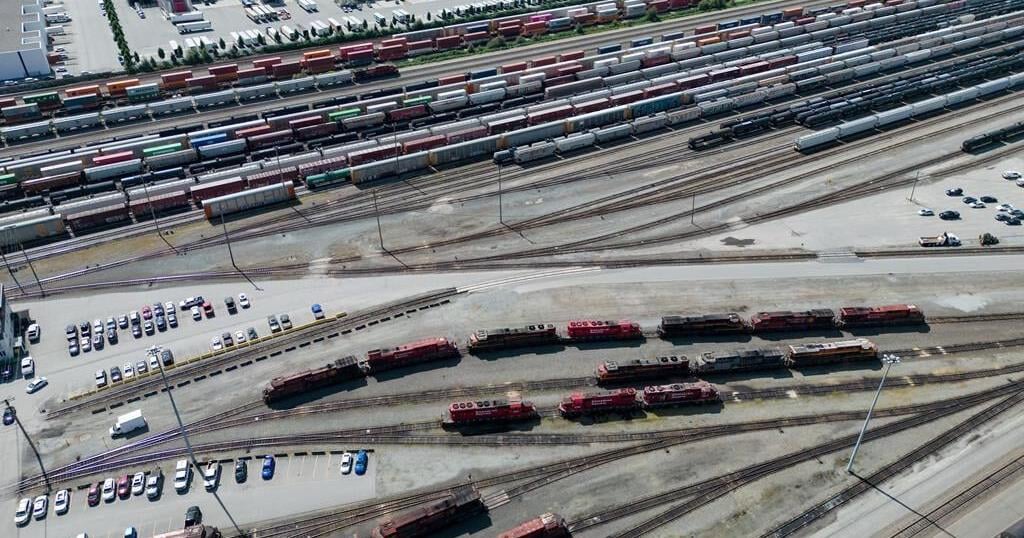MONTREAL – Negotiators returned to the bargaining table Thursday after Canada’s two largest railways locked out their employees after midnight in an unprecedented shutdown of freight traffic across the country.
Following months of increasingly bitter negotiations, shipments at Canadian National Railway Co. and Canadian Pacific Kansas City Ltd. ground to a halt last night, threatening to upend supply chains still reeling from pandemic-related disruptions and a port strike last year.
Rail workers from Halifax to Vancouver set up picket lines on Thursday morning, while sign-toting employees demonstrated outside CN’s headquarters in downtown Montreal and CPKC’s head office in Calgary.
Each side has accused the other of failing to negotiate seriously. Both railways have called for binding arbitration, which the Teamsters Canada Rail Conference union has rejected.
“We believe that this thing has to be settled at the bargaining table,” Teamsters Canada president François Laporte told reporters in Montreal.
“We don’t believe in letting a third party decide what’s going to be the working conditions of these people for the next two, three, four, five years.”
The union has said both companies are pushing to weaken protections around rest periods and scheduling. CN also aims to implement a “relocation scheme” that would see some employees move to far-flung locations for several months at a time to fill labour gaps, the Teamsters say.
“They want to get rid of language that would put our health and safety and lifestyle in jeopardy,” Laporte said.
CN said it has negotiated in good faith over the past nine months.
“The company consistently proposed serious offers, with better pay, improved rest and more predictable schedules. The Teamsters have not shown any urgency or desire to reach a deal that is good for employees, the company and the economy,” CN said.
In addition to the freight traffic, the impasse has also affected upwards of 32,000 commuters in Toronto, Montreal and Vancouver whose lines run on CPKC-owned tracks. Passenger trains cannot roll along those rails without the 80 locked-out traffic controllers on hand to dispatch them.
“The rail shutdown at CN and CPKC is already costing workers, transit users and businesses across the country, and we cannot afford to let things get worse,” Ontario Premier Doug Ford posted on X on Thursday morning.
Pressure from industry groups and government to resolve the bargaining impasse has been mounting for weeks, with calls to hash out a resolution ratcheting up further after the work stoppage kicked off.
Business groups have demanded that Ottawa step in by imposing binding arbitration and barring strikes and lockouts in the interim.
“The minister of labour must use the tools at his disposal to immediately resolve this conflict through binding arbitration,” said Canadian Chamber of Commerce chief executive Perrin Beatty in a statement Thursday. Ottawa could have prevented the unprecedented shutdown, he said, but chose not to.
Railways ship about $1 billion in goods each day, according to the Railway Association of Canada. Most of the 180,000-plus railcars that CN and CPKC haul weekly — moving everything from cars to clothes, computers, wheat and fertilizer — were already sidelined by Wednesday under a phased wind-down that began last week.
Moody’s warned that the work stoppage could cost the Canadian economy $341 million per day, with agriculture, forestry and manufacturing among the hardest-hit sectors.
The Teamsters represent 6,000 CN workers and 3,300 CPKC workers. The two companies typically hammer out new deals with employees a year apart, but in 2022 CN asked for a yearlong extension to the current collective agreement, throwing the bargaining periods into lockstep.
Prime Minister Justin Trudeau has called on both sides to work out a deal at the bargaining table.
“We are not taking this lightly, obviously, because Canadians across the country are worried about it,” he told reporters in Sherbrooke, Que., on Thursday.
NDP Leader Jagmeet Singh warned that the party’s confidence-and-supply agreement with the Liberal party would break if the minority government introduces back-to-work legislation in a confidence vote.
Engineers — drivers — earn $150,000 a year on average and conductors, whose role involves placing cars and loading cargo, earn $121,000 before benefits, according to CN. It says they work roughly 160 days a year — shifts that can involve long hours in freezing conditions far from home.
CPKC has said employees earn comparable but slightly lower amounts.
The railroad operator said Thursday it has sought a three-year “status quo” contract — no fundamental changes — with higher wages that outpace inflation.
The effects of the work stoppage have rippled out beyond Canada’s borders.
U.S. railways have had to turn away Canada-bound shipments. American shippers also rely on Canada’s two main railways, whose tracks run to the Gulf of Mexico and, in CPKC’s case, to terminals in southern Mexico.
Meanwhile, Canadian ports fear containers will pile up on the docks as cargo goes unmoved, causing congestion and prompting some carriers to reroute to U.S. terminals.
This report by The Canadian Press was first published Aug. 22, 2024.
Companies in this story: (TSX:CNR, TSX:CP)
— With files from Morgan Lowrie in Montreal and Bill Graveland in Calgary
